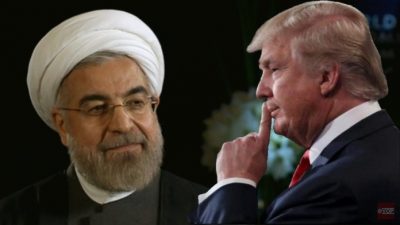The US and Iran Flex Their Muscles. The Iran Nuclear Deal (JCPOA) One Year after US Withdrawal

One year after the US unilateral withdrawal from the Iran nuclear deal (known also as JCPOA- Joint Comprehensive Plan Of Action), the US is flexing its muscles by announcing an already previously scheduled departure of the Abraham Lincoln Carrier Strike Group as a measure to frighten Iran and force it to the negotiation table. Iran responded by showing a video that included several US Navy in the Persian Gulf as potential targets to its forces. Both messages clearly aim to avoid a war. This is why Iran is expected to refer back to resolutions 26, 36 and 37 to send a warning to the UN to rectify the violation of the deal by the US or else Tehran will be in its legal position to “cease performing its commitments in whole or in part”. This is what President Hassan Rouhani is expected to announce tomorrow Wednesday the 8thof May, according to Iranian official sources, who expect Iran to stay in the deal for now.
“Iran doesn’t want to trigger a hostile reaction from the United Nations and its European allies, so that they do not join the US in imposing sanctions as they did in 2011. This is why Iran will remain as a signature member of the JCPOA. Today, those who praised and signed the nuclear deal are standing, if only verbally, against the US unilateral withdrawal from the deal and its imposition of one-sided sanctions”, said the official source to me.
Iran is expected to abide by the article 26, calling upon the US administration, the President and the Congress to “refrain from imposing new nuclear-related sanctions… re-introduce or re-impose sanctions specific in Annex II”. According to article 26, US failure to respect the deal will offer Iran “ground to cease performing its commitments under this JCPOA in whole or in part”.

Source: author
Iran is expected to invoke Article 36 that states “if Iran believed that any of the EU+3 were not meeting their commitments under this JCPOA, Iran could refer the issue to the Joint Commission for resolution…that will have 15 days to resolve the issue, unless the time period is extended by consensus”. Therefore, the Iranians responsible are not expected to go to a military war against the US but to adopt a gradual legal step before using its right to break its commitments, partially or fully.
According to Iranian sources, those in Iran calling for “an immediate and complete withdrawal from the JCPOA failed to convince the majority of decision-makers to adopt a radical approach, unless the UN and Europe (United Kingdom, France and Germany) were to fail to lift the sanctions on Iran and do nothing to support Iranian export of oil and import of needed technology and goods. Iran would then have the option of disregarding concerns related to Arak Nuclear Complex heavy water production plant to produce and reprocess weapons-grade plutonium and to restart unrestricted enrichment”.
It is clear that Iran doesn’t want to close the Strait of Hormuz, as much as it is clear that the US is not looking for a military confrontation with Iran. The US Navy, as a normal procedure, is still in regular contact with the Iranian Revolutionary Guard Corps (IRGC) stationed at the entrance of the Hormuz Strait, even if the IRGC is on the US terrorism list.

Source: author
The US administration would have preferred to support a Middle Eastern country willing to declare war on Iran. Nevertheless, Iran is not Yemen and has destructive fire power sufficient to dissuade any regional country from attacking it. Thus, a war with a slim chance of a favourable outcome for the West is not expected despite the rise of tensions in the Persian Gulf.
The US is failing to intimidate Iran and force it to the negotiation table. The US demands, composed of 12 points, are and will remain impossible for Iran to meet or to come close to. Iran will never withdraw from Syria unless on the request of President Bashar al-Assad, and is not in a position to cease its supports to its partners in the Middle East unless the constitution is amended. And last, Iran considers its missile production a defensive strategy against any possible aggression. This strategy reflects Iran’s experience during the Iraq-Iran war in 1980’s, when Iran was much less well equipped than it is today.
Notwithstanding overwhelming US military capabilities, the US administration is sending signals of weakness to its regional allies and to Iran. Tehran’s challenges to the US are also watched carefully by the Gulf countries who will think carefully before confronting Iran any time in the future.
President Hassan Rouhani has rejected Trump’s request for a meeting eight times. The US administration will, without any doubt, fail to bring Iran to the negotiation table by sending the Abraham Lincoln Carrier Strike Group and seems incapable of imposing zero oil export on Iran. The Middle East is boiling and miscalculations can be expected. Nevertheless, it is more about a show of force than about the possibility of war.
*
Note to readers: please click the share buttons below. Forward this article to your email lists. Crosspost on your blog site, internet forums. etc.

